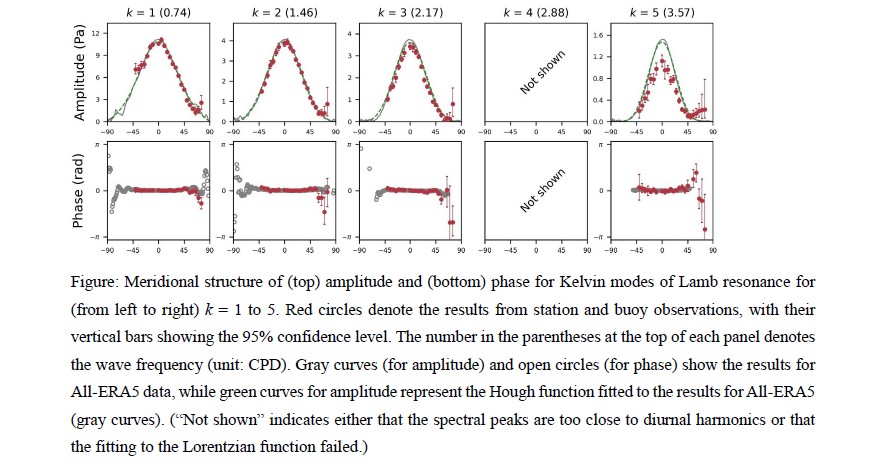JMSJ Highlights
Editor's Highlight : Sakazaki and Schindelegger (2025)
Sakazaki, T., and M. Schindelegger, 2025: Global atmospheric normal modes identified in surface barometric observations.
J. Meteor. Soc. Japan
,
103
,
https://doi.org/10.2151/jmsj.2025-019
Graphical Abstract
Editor in charge: Shigenori Otsuka
-
I highlight this paper, which describes a novel approach to detect normal mode oscillations in the real atmosphere.
- For each mode, a time series of its index is constructed using ERA5, and the raw barometric measurement data are then regressed onto this index to identify coherent signals corresponding to the normal mode signals in ERA5.
- It is confirmed that normal mode signals previously identified in ERA5 do exist in the real atmosphere, not only for low-frequency modes such as Rossby and Rossby-gravity modes but also high-frequency modes such as Kelvin and inertia-gravity modes and even a few modes of Pekeris resonance.
- Owing to data assimilation, ERA5 can reproduce even global wave signals with surface pressure amplitudes of 0.1~1 Pa.

Abstract
The earliest attempts to study the global normal mode oscillations of the atmosphere used time series of barometric in situ observations, but such approach is limited by the spatial and temporal inhomogeneity of meteorological station data. A major advance on the subject was recently made by applying a zonal-time spectral analysis to the surface pressure field in hourly gridded ERA5 reanalysis data, which disclosed an array of spectral peaks at theoretically predicted zonal wavenumber-frequency pairs, including many peaks with periods between 2 and 12 hours. However, this result relies on adequate representation of the modes in ERA5, which (i) ingests data sources that cannot explicitly resolve high frequency modes (e.g., radiosondes and polar satellite observations), and (ii) employs a numerical forward model that potentially introduces spurious effects. The present study provides "ground truth" for the reanalysis by a simple analysis of hourly barometric observations taken at ~3800 stations over the globe. For each putative global mode, a time series of its index is computed by filtering the hourly ERA5 pressure fields. This index is then regressed onto the station data, revealing, for each mode, a characteristic, globally coherent spatial pattern of regression coefficients. The meridional structures of the regression patterns agree fairly well with the corresponding Hough functions, not only for low-frequency Rossby and Rossby-gravity modes, but also for high-frequency modes such as Kelvin and inertia-gravity modes. Even the Pekeris resonance is identified for a couple of Kelvin modes. These findings both solidify the evidence for a rich spectrum of global normal modes in the real atmosphere and also lend credence to their representation in ERA5. It is impressive that ERA5, by combining a numerical model with scattered meteorological observations, even reproduces the tiny (~0.1-1 Pa amplitude) pressure signals of the high-frequency global normal modes.






